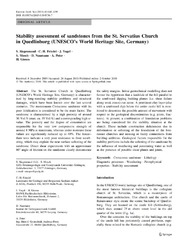Stability assessment of sandstones from the St. Servatius Church in Quedlinburg (UNESCO’s World Heritage Site, Germany)
Siegesmund, S.
Friedel, C.-H.
Vogel, J.
Mosch, S.
Naumann, D.
Peter, A.
Giesen, H.
63, 3: 641 - 659
DOI: https://doi.org/10.1007/s12665-010-0736-7
Persistent URL: http://resolver.sub.uni-goettingen.de/purl?gldocs-11858/6998
Persistent URL: http://resolver.sub.uni-goettingen.de/purl?gldocs-11858/6998
Siegesmund, S.; Friedel, C.-H.; Vogel, J.; Mosch, S.; Naumann, D.; Peter, A.; Giesen, H., 2010: Stability assessment of sandstones from the St. Servatius Church in Quedlinburg (UNESCO’s World Heritage Site, Germany). In: Environmental Earth Sciences, Band 63, 3: 641 - 659, DOI: 10.1007/s12665-010-0736-7.
 |
Dokument öffnen: |
The St. Servatius Church in Quedlinburg (UNESCO’s World Heritage Site, Germany) is characterised by long-standing stability problems and structural damages, which have been known over the last several centuries. The monotonous Cretaceous sandstone with its poor lithification is considered to be the main factor. The sandstone is characterised by a high porosity of around 30 Vol.% (max. ca. 35 Vol.%) and a corresponding high w-value. The porosity and the degree of cementation are responsible for the very low compressive strength of around 8 MPa at maximum, whereas under moisture these values are significantly reduced up to 40%. The freeze–thaw tests indicate a very poor resistance to frost weathering, which may explain the near-surface softening of the sandstone. Direct shear experiments with an approximate 60° angle of friction on the sandstone clearly demonstrate the safety margins. Initial geotechnical modelling does not favour the hypothesis that a landslide of the hill parallel to the southward dipping bedding planes (i.e. shear failure along weak zones) can occur. A prominent clay layer (also with a southward dip) below the entire castle hill is monitored to determine the possible amount of movement with respect to the geological discontinuities (e.g. joints, fractures). At present, a combination of foundation problems are being considered for the stability situation at the church. These include construction deficiencies due to deformation or softening of the foundation of the forerunner churches and missing or faulty connections from building additions. Geological factors responsible for the stability problems include the softening of the sandstone by the influence of weathering and penetrating water as well as the presence of possible shear planes and joints.
Statistik:
ZugriffsstatistikSammlung:
- Geologie [931]

